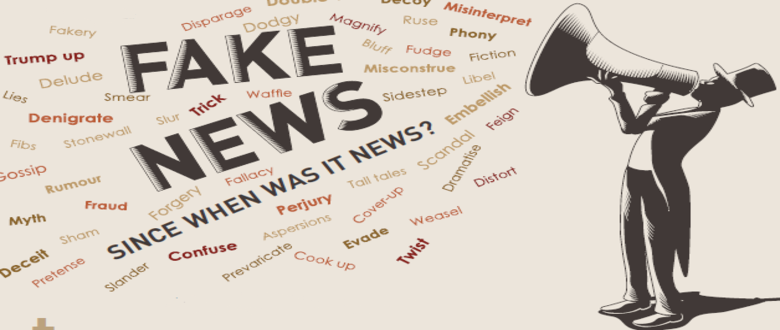“Fake” News: Since When Was It News?
Lying, as it appears, is as old as history. Farish A. Noor explains.

There has been much talk about “fake news” all over the Internet these days and how facts no longer seem to matter in the “post-factual” society we live in.
For sometime now, analysts and commentators have bemoaned the fact that many people no longer feel the need to verify what they read and watch online and on TV, and that populist politicians have been able to harness the emotional energy of angry and frustrated people to further agendas of their own, which include capturing state power and controlling governments.
While some of these concerns seem genuine enough, the phenomenon of people choosing to believe what they want to believe is hardly new, as any historian would point out. Perhaps the most obvious, and at times spectacular, aspect of the current phenomenon of “fake news” is the volume of information (or misinformation) disseminated, and the speed with which such misinformation travels. This has less to do with declining intelligence in general, but more to do with the kind of communicative technologies we have created.
But if we look back at developments in our own part of the world (Southeast Asia) a hundred years ago, we would see that the present state of communications and information technology has merely evolved at its own pace; and what strikes some as novel or even potentially dangerous is really the culmination of a long process of technological advancement.
In the 19th century, when Southeast Asia was carved up by the colonial powers of Western Europe, there was already a clear connection between communications technology and power. The British, Dutch, French, Spanish and Portuguese empires were held together not only by force and the constant threat of violence, but also by the latest innovations in communications.
Britain’s empire was held together by data, as argued by Thomas Richards in The Imperial Archive (1993); while Bernard Cohn has shown in Colonialism and its Forms of Knowledge (1996) how imperial rule in South and Southeast Asia was maintained through the building of vast systems of knowledge and information.
All this information and news was collected, collated and disseminated through technologies that were cutting-edge at the time: the telegraph, the printing press and the newspaper. Though some of these technologies may seem dated and redundant now, they were, at the time, superior means of data-collecting that kept entire empires together: Through the telegraph, Britain could maintain close contact with all her colonies from Africa to Asia, and it was this that created the “imagined community” of the imperium where the sun never set.
Yet it also has to be emphasised that much of what passed as “news” and “information” back then was also pure bunkum and nonsense.
Empires may have been built on information, but their power was often legitimised and reproduced through misinformation, distortion and outright lies as well. Again, the history of Southeast Asia is instructive here: when Britain turned its sights on Burma, the Kingdom of Burma was seen and cast in a decidedly negative light by colonial scholars and reporters.
News reports emerged and were circulated across the empire, about the alleged wrongdoings of the Burmese towards their own people and their neighbours. The popular theme at the time was the idea that Burma was a “belligerent power”, bent on becoming a dangerous “Asiatic empire”. Burma was referred to as “the Burman Empire” in maps and news reports, though the fact was that the real empire was Britain, and it was Britain that posed an existential threat to Burma, as it spread its power across much of northern India.
Similar examples of colonial-era “fake news” can be found elsewhere: The invasion of Brunei was justified on the spurious grounds that Brunei was a “den of pirates” and that the pirates of Borneo were a threat to freedom of movement at sea.
Elsewhere across Asia – from China to Japan – Asian nations were portrayed as the enemies of free trade and economic liberalism, for the simple reason that they did not wish to open their ports to foreign commerce.
If one were to read news reports and popular fiction of the 19th century through the lens of a historian, one can see that the logic of “fake news” hasn’t changed very much since the 19th century. Some of the vocabulary may have evolved since then, and terms like “Asiatic despot”, “piratical kingdom” and “Oriental empire” have merely been replaced with contemporary equivalents such as “rogue state” and “militant threat” – but they remain instrumental fictions nonetheless.
But if misinformation and distortion remain the constants in the way we discuss and speak of the world, does this mean that nothing has really changed, and that there is no hope for a more informed and enlightened future?
Again, we need to turn to history to see how societies can and do cope with the manipulation of knowledge and data. One of the ironies of “empire” is that while it laid the foundations for a vast network of communications and power projection across the globe, it also planted the seeds of its eventual demise.
Like the Roman Empire, whose roads were used to project Roman power far beyond the walls of its capital, but which were later used by the very same enemies to invade it, 19th-century empires also provided the means for colonial subjects to resist and reject.
Nineteenth-century imperialism was couched in terms of a “civilising mission” to bring enlightenment and modernity to Africa and Asia, but what it delivered – in real terms – were roads, telegraph lines, printing presses and schools. In time, the very same colonial subjects would use the very same communicative technologies to fight back, and it is not a surprise that by the turn of the 20th century, native vernacular printing presses were emerging all over the colonies, from India to Southeast Asia. (Singapore was, in fact, one of the major centres of native vernacular printing by then, and local intellectuals and activists were at the forefront of the intellectual resistance to colonial rule.)
Powerful though the European empires were, there was a limit to their capacity to deliver “fake news” and misinformation: The point was reached when colonial subjects no longer believed what they read in the colonial press, and called for “alternative” (read: “Asia-centric”) news instead.
At a glance, it would seem that we are back to that historical moment when “facts” are no longer seen as facts. Those who lament the current phenomenon of “fake news” may be a tad too cynical for their own good, for they seem to assume the public believes whatever it sees and reads blindly. Since when was this the case? And since when was “fake news” news in the first place?
A century ago, millions of Asians came to the simple and mundane realisation that the colonial powers had no intention of doing them any good, and that all talk of a “civilising mission” was merely hollow propaganda. That awareness was the key that unlocked a host of other political and ideological alternatives, and paved the way for national liberation across Asia.
Today, we can all see that much of what is said, written or tweeted by some politicians and celebrities is equally nonsensical, and does not deserve serious attention.
This is equally liberating as it clears the deck of senseless distractions, and reminds us that there are more important things to do in life than wasting our time “liking” posts on Facebook or tweeting about what you had for breakfast this morning.
This article was first published in The Straits Times on 25 March 2017. © Farish A. Noor and Singapore Press Holdings. Reprinted with permission.
 Farish A. Noor is Associate Professor at the S.Rajaratnam School of International Studies, Nanyang Technological University. He is a regular contributor to BiblioAsia.
Farish A. Noor is Associate Professor at the S.Rajaratnam School of International Studies, Nanyang Technological University. He is a regular contributor to BiblioAsia.

